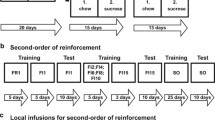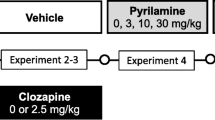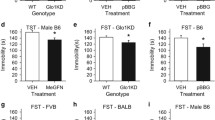Abstract
Administration of fenfluramine to rats produced decreases in 1-h food intake and locomotor activity. Short-term (2–6 days) or long-term (21–25 days) treatment with the monoamine oxidase (MAO) type A inhibiting antidepressant clorgyline potentiated fenfluramine-induced suppression of food intake but did not affect fenfluramine-induced suppression of locomotor activity. Although daily (4 h) food intake was not significantly less in clorgyline-treated animals relative to saline-treated controls, body weight gain was significantly less in clorgyline-treated animals relative to controls. These findings demonstrate a differential effect of clorgyline treatment on fenfluramine-induced suppression of food intake and locomotor activity.
Similar content being viewed by others
References
Ahlskog JE, Randall PK, Hoebel BG (1975) Hypothalamic hyperphagia: dissociation from noradrenergic depletion hyperphagia. Science 190:399–401
Aulakh CS, Cohen RM, Pradhan SN, Murphy DL (1983) Self-stimulation responses are altered following long-term but not short-term treatment with clorgyline. Brain Res 270:383–386
Aulakh CS, Cohen RM, Hill JL, Murphy DL, Zohar J (1987) Long-term imipramine treatment enhances locomotor and food intake suppressant effects on m-chlorophenylpiperazine in rats. Br J Pharmacol 91:747–752
Blundell JE (1977) Is there a role of serotonin (5-hydroxytryptamine) in feeding? Int J Obes 1:15–42
Blundell JE, Latham CJ (1980) Characterization of the adjustment to the structure of feeding behavior following pharmacological treatment: effects of amphetamine and fenfluramine and the antagonism produced by pimozide and methergoline. Pharmacol Biochem Behav 12:717–722
Campbell IC, Robinson DS, Lovenberg W, Murphy DL (1979) The effects of chronic regimens of clorgyline and pargyline on monoamine metabolism in the rat brain. J Neurochem 32:49–55
Charney DS, Heninger GR, Sternberg DE (1984) Serotonin function and mechanism of action of antidepressant treatment. Arch Gen Psychiatry 41:359–365
Clineschmidt BV (1973) 5,6-Dihydroxytryptamine suppression of the anorexigenic action of fenfluramine. Eur J Pharmacol 24:405–409
Cohen RM, Campbell IC, Dauphin M, Tallman JF, Murphy DL (1982) Changes in α- and β-receptor densities in rat brain as a result of treatment with monoamine oxidase inhibiting antidepressants. Neuropharmacology 21:293–298
Cohen RM, Aulakh CS, Murphy DL (1983) Long-term clorgyline treatment antagonizes the eating and motor function responses to m-chlorophenylpiperazine. Eur J Pharmacol 94:175–179
Copp FC, Green AF, Hodson HF, Randall AW, Sim WF (1967) New peripheral antagonist of 5-hydroxytryptamine. Nature 214:200–201
Costall B, Naylor RJ, Marsden CB, Pycock CJ (1976) Serotonergic modulation of the dopamine response from the nucleus accumbens. J Pharm Pharmacol 28:523–526
Curzon G, Dourish CT, Kennett GA (1987) 5-HT1B agonists cause anorexia at postsynaptic receptors. Br J Pharmacol (in press)
Fletcher PJ, Burton MJ (1986) Dissociation of the anorectic actions of 5-HTP and fenfluramine. Psychopharmacology 89:216–220
Garattini S, Buczko W, Jori A, Samanin R (1975) The mechanism of action of fenfluramine. Postgrad Med J [Suppl 1] (51):27–35
Garattini S, Caccia S, Mennini T, Samanin R, Consolo S, Ladinsky J (1979) Biochemical pharmacology of the anorectic drug fenfluramine: a review. Curr Med Res Opin [Suppl 1] 6:15–27
Geyer MA, Puerto A, Dawsey WJ, Knapp S, Bullard WP, Mandell AJ (1976) Histologic and enzymatic studies of the mesolimbic and mesostriatal serotonergic pathways. Brain Res 106:241–256
Glue PW, Cowen PJ, Nutt DJ, Kolakowska T, Grahme-Smith DG (1986) The effect of lithium on 5-HT-mediated neuroendocrine responses and platelet 5-HT receptors. Psychopharmacology 90:398–402
Hollister AS, Ervin GH, Cooper BR, Breese GR (1975) The roles of monoamine neural systems in the anorexia induced by (+) amphetamine and related compounds. Neuropharmacology 14:715–723
Meltzer HY, Lowy M, Robertson A, Goodnick P, Perline R (1984) Effect of 5-hydroxytryptophan on serum cortisol levels in major affective disorders. Arch Gen Psychiatry 41:391–397
Murphy DL, Aulakh CS, Garrick NA, Sunderland T (1987) Monoamine oxidase inhibitors as antidepressants: implications for the mechanism of action of antidepressants and the psychobiology of the affective disorders and some related disorders. In: Meltzer HY (ed) Psychopharmacology: the third generation of progress. Raven Press, New York, pp 545–552
Olpe HR, Schellenberg A (1981) The sensitivity of cortical neurons to serotonin: Efect of chronic treatment with antidepressants, serotonin uptake inhibitors and monoamine oxidase blocking drugs. J Neural Transm 51:233–244
Pijnenburg AJJ, Honig WMM, Vanderheyden JAM, Van Rossum JM (1976) Effects of chemical stimulation of the mesolimbic dopamine system upon locomotor activity. Eur J Pharmacol 35:45–58
Rowland NE, Carlton J (1986) Neurobiology of an anorectic drug: fenfluramine. Prog Neurobiol 27:13–62
Samanin R, Ghezzi D, Valzelli L, Garattini S (1972) The effects of selective lesioning of brain serotonin or catecholamine neurones on the anorectic activity of fenfluramine and amphetamine. Eur J Pharmacol 19:318–322
Savage DD, Mendels J, Frazer A (1980) Decrease in [3H]-serotonin binding in rat bain produced by the repeated administration of either monoamine oxidase inhibitors or centrally acting serotonin agonists. Neuropharmacology 19:1063–1070
Sills MA, Wolfe BB, Frazer A (1984) Determination of selective and non-selective compounds for the 5-HT1A and 5-HT1B receptor subtypes in rat frontal cortex. J Pharmacol Exp Ther 231:480–487
Sugrue MF (1983) Chronic antidepressant therapy and associated changes in central monoaminergic receptor functioning. Pharmacol Ther 21:1–33
Weiss GF, Papadakos P, Knudson K, Leibowitz SF (1986) Medial hypothalamic serotonin: Effects of deprivation and norepinephrine-induced eating. Pharmacol Biochem Behav 25:1223–1230
Zohar J, Insel TR, Zohar-Kadouch RC, Hill JL, Murphy DL (1988) Serotonergic responsivity in obsessive-compulsive disorder. Effect of chronic clomipramine treatment. Arch Gen Psychiatry 45:167–172
Author information
Authors and Affiliations
Additional information
Offprint requests to: C. S. Aulakh
Rights and permissions
About this article
Cite this article
Aulakh, C.S., Hill, J.L., Wozniak, K.M. et al. Fenfluramine-induced suppression of food intake and locomotor activity is differentially altered by the selective type A monoamine oxidase inhibitor clorgyline. Psychopharmacology 95, 313–317 (1988). https://doi.org/10.1007/BF00181939
Received:
Revised:
Issue Date:
DOI: https://doi.org/10.1007/BF00181939




